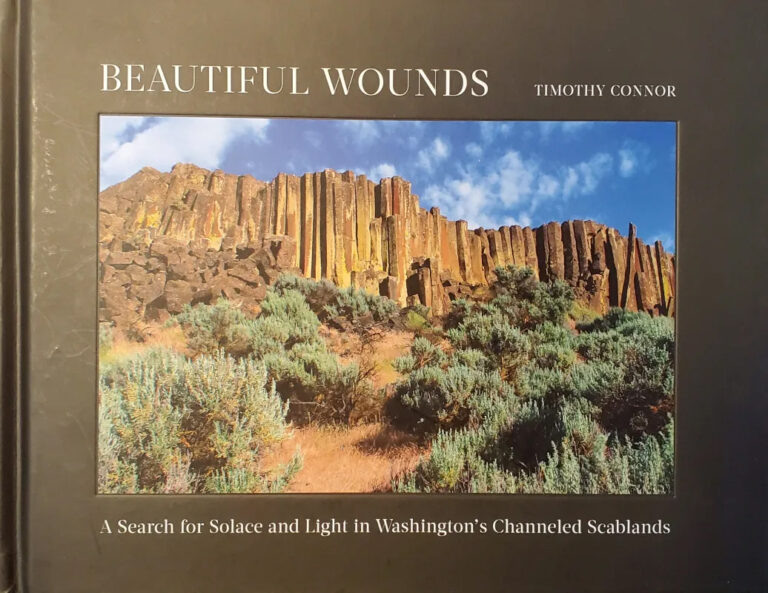Belts are tight and land is cheap. Many landowners are eager to sell. Conservation Futures, Spokane County’s environmental preservation program, is ready to buy.
For the first time in five years, one of Spokane County’s most popular programs, Conservation Future,s opened its e-mail account this summer for property nominations. They’re seeking willing sellers for prime conservation land. We’re certain that e-mail account is now exceeding capacity.
“In our last round, we were in the upper 20’s. We have 36 this time,” says Spokane County Parks Director Doug Chase. “I think we estimated three to five [properties will be purchased] in this cycle.”
In this month’s preliminary round of examinations, the Conservation Futures evaluation team will narrow down the list to a more manageable number. Once properties are ranked, the top qualifiers will undergo property value assessments. A select few will be pursued for purchase.
And you, the county taxpayer funding all this, have a say. Conservation Futures invites you to a public meeting on October 12th from 6:00 pm – 9:00 pm at the IMAX Theater in Riverfront Park to tell the committee which properties you’d like to see purchased.
CONSERVATION WHO?
Conservation Futures uses a small portion of the county’s property tax money to purchase land and convert it to publicly accessible conservation areas. Fifteen percent of the $1.7 million-per-year fund goes to maintaining, protecting and enhancing already-acquired areas. The tax caps out at six cents on every $1,000-worth of property.
Before you get all indignant about the county spending your money, consider this: Each time the advisory vote was held, public support for the program grew. The program showed 63 percent support in a 2007 public advisory vote in advance of the County Commission decision, up from 54 percent in 1997.
Lunell Haught, Inland Northwest Trails Coalition vice president and Conservation Futures Land Evaluation Committee member, led the Conservation Futures campaigns in advance of public advisory votes each of the three times the program was put up for a public advisory vote. (The final decision to renew funding was made by a County Commission vote.)
“Sometimes you have to give the commissioners political cover to have a tax,” she says. “We did that three different times. The last time, we took out the ‘for five years’—because it cost us [around] $10,000 every time we took it to a public vote.”
The program, which exists in many other Washington counties, was voted in for three years by the Spokane County Commission in 1994. The program was renewed for five years in 1997 and again for five more years in 2002. The third time, in 2007, Conservation Futures funding was renewed without a five-year sunset clause.
In past years, Conservation Futures has acquired 20 properties—eight of those within Spokane city limits. Among those are the Camp Sekani, Rimrock, Liberty Lake and MacKenzie Conservation Areas. Many of the properties connect trails or parks and allow for the full spectrum of non-motorized outdoor recreation. Some keep riverbanks or lakesides undeveloped. All of them preserve existing wildlife.
AT-RISK LAND
“It’s important for the public to know that this tax was hard fought for,” says former County Commissioner John Roskelley. “A lot of [other Eastern Washington] counties won’t even put it on the ballot.”
Roskelley says the county saw the need for a Conservation Futures program because urban sprawl was encroaching on key wildlife areas. “The main pitch, I believe, was that we were losing valuable conservation land on an annual basis due to development,” he says. “The wetlands, the shorelines—the pieces that were obvious targets of development and were soon going to disappear.”
Holding development at bay remains urgent for current Conservation Future nominators. The Vista Trails property has been approved for 107 individual lots as part of the Legacy Ridge development, but developer Marshall Chesrown surrendered the property to AmericanWest Bank last year to avoid foreclosure.
“The bottom fell out of everything, but there’s no doubt in my mind that in the next cycle, it would be developed,” says Mike Pinch, NAI Black managing member who submitted the proposal on behalf of the bank.
The ten Beacon Hill nominations are currently used for recreation. Most of the properties in the group are developer-owned, and one is owned by Avista Utilities.
“The trail system [already exists] on these parcels, but we are not guaranteed permanent access or easements on these properties because they are privately owned,” says Beacon Hill Advisory Board Coordinator Penny Schwyn. “We just haven’t been able to proceed beyond a handshake agreement prior to this point.”
WHAT IT TAKES
To throw their hat into the ring, nominators submit a proposal including information about the recreational, wildlife and riparian habitat value of the property, a location map, and photos of the site. They may also submit letters of support – often from groups like Inland Northwest Land Trust (INLT) and the Inland Northwest Trails Coalition.
“Every time [a new nomination cycle] opens, we get a flood of request for letters of support,” says Andrea Hannon, INLT’s conservation director, “Its hard to make sure we don’t just write a letter for every property that comes in. [We] tend to work on projects we know and have spent a lot of time on.”
This year, the INLT nominated a Knight’s Lake property, which would expand the McLellan Conservation Area purchased by Conservation Futures in 1995.
After nominations are received, the Land Evaluation Committee—comprised of staff from the county, the cities of Spokane and Spokane Valley, and local conservation advocates—work to narrow down the list. The evaluation committee surveys properties with a Washington State wildlife biologist in tow. According to Parks Director Doug Chase, the biologist “helps the evaluators understand from a wildlife standpoint what they might be looking at.”
Next, the public is brought into the discussion. (In anticipation of saying your piece, check out the completed nomination forms and map on the Conservation Futures website.)
The evaluation committee then makes its final selections, which are appraised, then considered by the County Commission.
“Several things go into determining the final purchase price,” says Spokane County Assistant Parks Director John Bottelli. “The very first being that we obtain is two independent [appraisals] to determine fair market value at the time of negotiation.”
Property values are frequently higher than the number listed by the County Assessor’s office, he says. Only then does the routine property-buying process begin.
The number of properties acquired is a wild card, says Chase. “It depends on a list of willing sellers and funds in the program. We will start at the top of the list, and then work our way through.” If a proposed property makes the top of the list but stalls, they’ll move on to the next property on the list. Some properties won’t actually be purchased for several years.
WHICH WILL IT BE?
With a few hundred grand in the bank, what kind of property would you purchase? A large stretch of land in the middle of nowhere? A smaller, pricier property in the urban core?
Conservation Futures considers many of the same factors that an individual buyer might: accessibility, space, what you can do on the land, and what’s already there.
“We’re doing both a qualitative and quantitative assessment,” says Lunell Haught.
The qualitative side of the analysis is, as Haught calls it, the “wow” factor.
The quantitative analysis takes recreation and conservation into account. The “recreation” section of the proposal includes factors like non-motorized recreation opportunities, trail connectivity, expansion of existing park land, accessibility, public support, and anticipated public usage. The “conservation” section considers wildlife and riparian (riverbank) attributes.
One form of recreation does not take preference over any other, says Botelli, but connectivity is regarded as a separate factor. In other words, a recreation property that adds to a trail or otherwise contributes to connectivity might be preferred over a stand-alone property with recreation potential. But a property ripe for mountain biking wouldn’t take preference over a great piece of potential hiking trail. For example, the Trolley Trail nomination will be considered for its recreation potential—a section of trail—as well as the fact that it connects two pieces of existing trail.
“Another conversation is, are there maintenance costs?” says Haught. “They’re proposing programs, and one of the questions is ‘how much non-government match do you have?’ ”
But cost is not the deciding factor, she says. “It’s either a valuable conservation property or it’s not.”
Doug Chase says cost is rarely a factor for ranking potential acquisitions. “Generally speaking, the cost has not driven whether or not a property would or would not be selected,” he says. Rather, properties are ranked prior to property value assessments being made on the top-ranking potential purchases. “It’s a small component of an overall description. The program has been designed so that the attributes of the property—not the cost—would determine its selection.”
A BIG LEAP
During his tenure as a county commissioner, Roskelley served on the Spokane County Parks Advisory Committee for eight years – including the period in which Conservation Futures began acquiring smaller, pricier city properties. The first of these properties, he says, was a property near the Downriver Golf Course that split Riverside State Park.
“[The land owner] had purchased a 2.5-acre piece that was originally for a retirement home. This was a key piece, because if he didn’t sell it to Conservation Futures, it would have been developed,” Roskelley says. “It was grandfathered in as a development, commercial piece.”
Conservation Futures purchased what became the Downriver Conservation Area for $250,000. “That was a huge step for the city, to make that leap form $2,000-5,000 per acre of rural land to $100,000 per acre,” says Roskelley. Prior to that purchase, Conservation Futures had erred on the side of purchasing lower cost-per-acre county properties.
“We received a note and a request from the City of Spokane saying [essentially], ‘if you want us to support this Conservation Futures tax, if you want us to promote it, then you’re going to have to bite the bullet and buy some land in the City of Spokane as well as in the county’,” says Roskelley. “The contentious part [is] that the land in the city is so expensive.”
City lands were much more expensive, says Roskelley. “That made some of the people on the committee balk. And they said, ‘No we’re not going to do this. We could protect far more land in the rural area.’ Since then, the city has received quite a bit of money, and obviously from the purchase of the [former site of the] YMCA, that’s going to continue.”
This year, 16 of the 36 nominations lie within the Spokane city limits.
BIG TICKET ITEM
Which brings us to that smallish elephant with a big price tag in the room —last year, the Park Board unanimously voted to support Conservation Futures’ acquisition of the now-vacant building, previously the Downtown YMCA, enveloped by city-owned Riverfront Park.
An urban property like the YMCA is more accessible—and protecting it means improving our urban landscape considerably. On the other hand, larger stretches of rural lands offer more bang for our taxpayer buck as far as preserving our wetlands, rivers, wildlife, native vegetation and air quality.
For some 17 years to come, $350,000 per year of Conservation Futures’ $1.7 million fund is reserved for paying for the acquisition of the YMCA property. (Another 15 percent is reserved for maintenance of previously acquired conservation land.)
The riverside property is less than one acre and weighs in at $5.39 million —of which the City of Spokane put down $1 million. Conservation Futures is responsible for covering $4.39 million. The county is seeking a one million dollar grant from the state’s Aquatic Lands Enhancement Account, which would be awarded in June 2011. The county’s application is currently ranked second on the candidate list. According to Leroy Eadie, director of Spokane Parks and Recreation, the YMCA building demolition will start this fall or winter. Getting this grant would reduce to 12 years from 17 for the payout from the Conservation Futures fund.
Despite resistance from some members of the Spokane City Council, and the public, Conservation Futures directors stand by their decision. “It’s gone through that exact same evaluation process as any other property that has been acquired,” says Chase.
CONSERVATION VS. RECREATION:
THE BATTLEGROUND
At its inception, proponents presented Conservation Futures to voters as a conservation program, says Haught.
“The message has always been ‘Clean air, clean water’,” she says. “I felt persuaded that this was the important part, because in my mind I see it more as a conservation program than a recreation [one].”
Roskelley remembers it the same. “There was some talk of recreation—hiking, birding, even some horseback riding. But these properties were strictly [being acquired] to protect the environment,” he says. “We were looking to get large pieces near rivers—the Little Spokane, Deadman [Creek] and wetlands.”
So what about recreation? Should accessibility and potential use receive equal consideration to preserving wildlife for the Conservation Futures priority list?
Haught says there’s a lot of latitude in the law. “There’s sort of a philosophical difference [regarding] what’s a good conservation futures acquisition.” With that, she says, comes some dissidence in the room when acquisitions are discussed.
“Preserving open space, whether it’s for animals or people, is vital to the human spirit,” says Penny Schwyn. “I think the county recognizes all the conservation land is used for moderate forms of recreation, but the priority is to hold it as open space. They kind of go hand-in-hand; you can’t have one without the other.”
NOTABLE NEW NOMINATIONS FOR CONSERVATION FUTURES
BEACON HILL (TEN NOMINATIONS)
ACRES: 76.75, 30, 40, 30, 15, 12.62, 5, 15, 40 and 16.
FEATURES: If all the properties are acquired, they will connect with five parks. The land is within walking distance of the Northeast Neighborhood. The properties are currently privately owned but open for public use, including hiking, mountain biking and trail running. Acquisition of these would prevent future development. “Each application has its own merits, but it was really important to us to have them considered as a whole as much as possible,” says Beacon Advisory Board Coordinator Penny Schwyn.
TROLLEY TRAIL (TWO NOMINATIONS)
ACRES: 6 and 1.
FEATURES: The proposed properties would connect two existing stretches of unpaved trail, and could make it possible to create a new spur off the Fish Lake Trail in the Grandview/Thorpe neighborhood.
KNIGHT’S LAKE
ACRES: 590
FEATURES: This property would add to the McLellan Conservation Area. Together, the properties would provide nearly 1,000 acres of connected open space with 1.85 miles of shoreline. The property supports wintering bald eagles and nesting osprey. Two native plants found on the property include Gray Stickseed and Nuttall’s pussy-toes, which received a sensitive listing by Washington State National Heritage.
VISTA TRAILS
ACRES: 585
FEATURES: This nomination includes the option for more than seven miles of hiking and mountain biking trails, which would be built by the current owner prior to purchase. The property contains springs and has beautiful views. Adjacent to the Legacy Hills housing development and already approved for development itself, this land is likely to be developed if not purchased by Conservation Futures.
Go online to see full info on the 2010 CF nominations map and use the public comment interface at:
www.spokanecounty.org/parks/cacomment.aspx
Here’s Timeline For The Rest Of The Cf Process:
OCTOBER 12 – Public Meeting to gather public comment on nominated properties at the IMAX Theater in Riverfront Park
NOVEMBER – LEC produces Prioritized Acquisition List and forwards to Parks Advisory Committee who forwards recommendation(s) to the BOCC.
DECEMBER – Board of County Commissioners considers recommended Prioritized Acquisition List.
2011 – Staff begin acquisition of top-ranked property(s).












